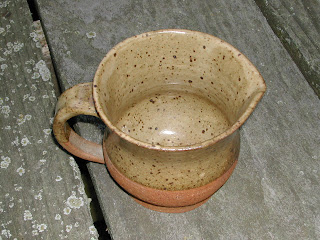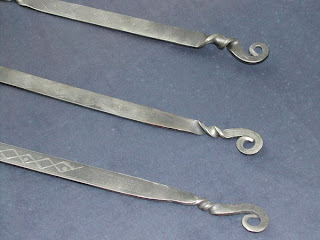Thought I'd follow up my last post with some more of my ceramic creations. The Organix series was an experiment for me in coil building. They are hand built of stoneware clay rolled into half-inch thick coils with the exterior suface showing them and the interior surface blended and worked to a smooth finish for strength. All pieces are salt-fired, drawing their glaze characteristics from the clay body itself. They stand approximately 32" tall and are completely hollow; no internal substructure for support.
This made them virtually impossible to successfully fire in the kiln for a number of reasons. Without internal structure, they stood a good chance of sagging or even collapsing during firing, when the temperatures would bring the clay up to nearly fluxing (turning liquid). The other problem was their height; in order to fit them into the kiln with other pieces, they had to be fired on the door sill. This put them in jeopardy when the firing was over and the door was slowly opened during the cooling phase. The introduction of colder air into the kiln could cause them to shatter due to the rapid temperature transitions. Any stress left in the clay body during the build would make them more vulnerable for failure.
As an attempt to mitigate some of the problems, I only used clay that had been carefully aged for 3-4 months. This ensured higher plasticity of the clay, and a more uniform moisture content in the body. I also built the pieces very slowly, allowing them to green-cure as they were being built. The pieces were worked on simultaneously for about a month, being added to in small stages. As the build progressed, they were tightly packed with newspaper that had been soaked with water and wrung out. This helped them cure more slowly, and left a pseudostructure of compressed paper inside of them for support.
One final decision was to do them as a continuous firing; no bisque first, then glaze. They would be brought up through the bisque, then on to the glaze firing in one shot. It was, to say the least, a bit of a nerve-wracking process! When the cool-down was complete, and the kiln door lowered, I have to say I was both proud and relieved. They had all survived the firing intact; the paper had flashed out when the kiln reached cone 10 (2381°F) and had left nothng but a small pile of ashes behind that was easily rinsed out of the pieces. The kiln gods had smiled, and I was in luck!
(click images for a closer view)
Organix I, II and III

Organix I, face view

Organix I, side view

Organix II, face view

Organix II, side view

Organix III, face view

Organix III, rear view




















































